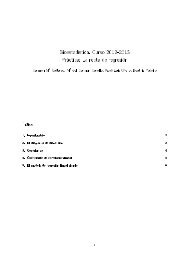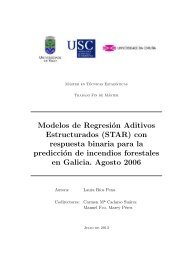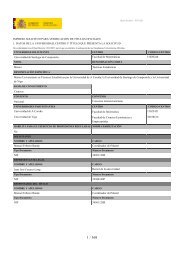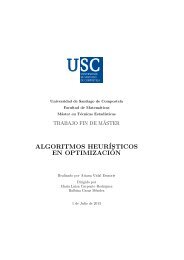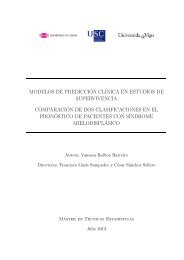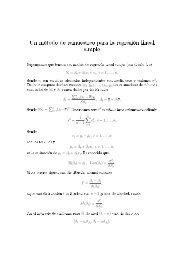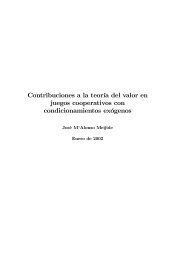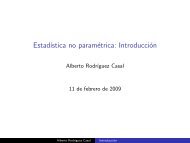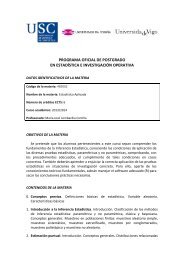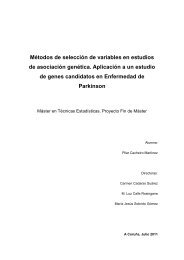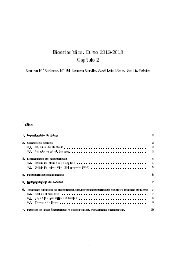Bootstrap independence test for functional linear models
Bootstrap independence test for functional linear models
Bootstrap independence test for functional linear models
You also want an ePaper? Increase the reach of your titles
YUMPU automatically turns print PDFs into web optimized ePapers that Google loves.
Y , that is, <strong>for</strong> <strong>test</strong>ing H 0 : Θ = 0 versus H 1 : Θ ≠ 0, on the basis of a simple random sample{(X i , Y i )} n i=1 drawn from (X, Y ). The bootstrap techniques will become an alternative useful toolwhen the asymptotics of <strong>test</strong> statistics are unknown or when they are inaccurate due to small samplesize.Since its introduction by Efron (1979), it is well–known that the bootstrap method results in anew distribution approximation which can be applied to a large number of situations, such as thecalibration of pivotal quantities in the finite dimensional context (see Bickel and Freedman (1981),and Singh (1981)). As far as multivariate regression <strong>models</strong> are concerned, bootstrap validity <strong>for</strong><strong>linear</strong> and non–parametric <strong>models</strong> was also stated in literature (see Freedman (1981), and Cao-Abad (1991)). Currently, the application of bootstrap to the <strong>functional</strong> field has been successfullystarted. For instance, Cuevas, Febrero, and Fraiman (2006) have proposed bootstrap confidencebands <strong>for</strong> several <strong>functional</strong> estimators such as the sample and the trimmed <strong>functional</strong> means. In theregression context, Ferraty, Van Keilegom, and Vieu (2010), and González-Manteiga and Martínez-Calvo (2011) have shown the validity of the bootstrap in the estimation of non–parametric <strong>functional</strong>regression and <strong>functional</strong> <strong>linear</strong> model, respectively, when the response is scalar. They have alsoproposed pointwise confidence intervals <strong>for</strong> the regression operator involved in each case. In addition,the asymptotic validity of a componentwise bootstrap procedure has been proved by Ferraty,Van Keilegom, and Vieu (2012) when a non–parametric regression is considered and both responseand regressor are <strong>functional</strong>.<strong>Bootstrap</strong> techniques can also be very helpful <strong>for</strong> <strong>test</strong>ing purposes, since they can be used in orderto approximate the distribution of the statistic under the null hypothesis H 0 . For example, Cuevas,Febrero, and Fraiman (2004) have developed a sort of parametric bootstrap to obtain quantiles<strong>for</strong> an ANOVA <strong>test</strong>, and González-Rodríguez, Colubi, and Gil (2012) have proved the validity ofa residual bootstrap in that context. Hall and Vial (2006) and, more recently, Bathia, Yao, andZiegelmann (2010) have studied the finite dimensionality of <strong>functional</strong> data using a bootstrap approximation<strong>for</strong> independent and dependent data, respectively.As was indicated previously, <strong>test</strong>ing the lack of dependence between X and Y is our goal. Thisissue has stirred up a great interest during the last years due to its practical applications in the<strong>functional</strong> context. For instance, Kokoszka, Maslova, Sojka, and Zhu (2008) proposed a <strong>test</strong> <strong>for</strong> lackof dependence in the <strong>functional</strong> <strong>linear</strong> model with <strong>functional</strong> response which was applied to magnetometercurves consisting of minute–by–minute records of the horizontal intensity of the magneticfield measured at observatories located at different latitude. The aim was to analyse if the high–latitude records had a <strong>linear</strong> effect on the mid– or low–latitude records. On the other hand, Cardot,Prchal, and Sarda (2007) presented a statistical procedure to check if a real–valued covariate has aneffect on a <strong>functional</strong> response in a nonparametric regression context, using this methodology <strong>for</strong> astudy of atmospheric radiation. In this case, the dataset were radiation profiles curves measured ata random time and the authors <strong>test</strong>ed if the radiation profiles changed along the time.Regarding the regression model (1), <strong>test</strong>ing the significance of the relationship between a <strong>functional</strong>covariate and a scalar response has been the subject of recent contributions, and asymptotic approaches<strong>for</strong> this problem can be found in Cardot, Ferraty, Mas, and Sarda (2003) or Kokoszka,Maslova, Sojka, and Zhu (2008). The methods presented in these two works are mainly based onthe calibration of the statistics distribution by using asymptotic distribution approximations. Incontrast, we propose a consistent bootstrap calibration in order to approximate the statistics distribution.For that, we firstly introduce in Section 2 some notation and basic concepts about theregression model (1), the asymptotic theory <strong>for</strong> the <strong>test</strong>ing procedure, and the consistency of thebootstrap techniques that we propose. In Section 3, the bootstrap calibration is presented as analternative to the asymptotic theory previously exposed. Then, Section 4 is devoted to the empirical2



